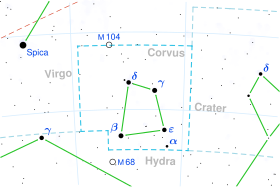Gamma Corvi
| Observation data Epoch J2000 Equinox J2000 |
|
|---|---|
| Constellation | Corvus |
| Right ascension | 12h 15m 48.37081s |
| Declination | –17° 32′ 30.9496″ |
| Apparent magnitude (V) | 2.585 |
| Characteristics | |
| Spectral type | B8 III |
| U−B color index | –0.344 |
| B−V color index | –0.111 |
| Astrometry | |
| Radial velocity (Rv) | -4.2 km/s |
| Proper motion (μ) |
RA: –158.61 mas/yr Dec.: +21.86 mas/yr |
| Parallax (π) | 21.23 ± 0.20mas |
| Distance | 154 ± 1 ly (47.1 ± 0.4 pc) |
| Details | |
| γ Crv A | |
| Mass |
4.2+0.4 −0.3 M☉ |
| Rotational velocity (v sin i) | 30 km/s |
| Age |
160+40 −30 Myr |
| γ Crv B | |
| Mass | 0.8 M☉ |
| Other designations | |
| Database references | |
| SIMBAD | data |
Gamma Corvi (γ Corvi, abbreviated Gamma Crv, γ Crv) is a binary star and the brightest star in the southern constellation of Corvus, having an apparent visual magnitude of 2.59. The system's two components are designated Gamma Corvi A (also named Gienah) and Gamma Corvi B. The distance to this system has been measured directly using the parallax technique, yielding an estimated 154 light-years (47 parsecs) from the Sun.
γ Corvi (Latinised to Gamma Corvi) is the system's Bayer designation. The designation of the components – Gamma Corvi A and B – derives from the convention used by the Washington Multiplicity Catalog (WMC) for multiple star systems, and adopted by the International Astronomical Union (IAU).
Gamma Corvi bore the traditional name of Gienah derived from Arabic, from Ulugh Beg's الجناح الغراب اليمن al-janāħ al-ghirāb al-yaman, meaning "the right wing of the crow", although on modern charts it marks the left wing. The star Epsilon Cygni also bore this traditional name and Gamma Corvi was referred to as Gienah Corvi or Gienah Ghurab to distinguish it from this star in Cygnus.
In 2016, the International Astronomical Union organized a Working Group on Star Names (WGSN) to catalogue and standardize proper names for stars. The WGSN states that in the case of multiple stars the name should be understood to be attributed to the brightest component by visual brightness. The WGSN approved the name Gienah for Gamma Corvi A on 6 November 2016 and it is now so entered in the IAU Catalog of Star Names.
...
Wikipedia

